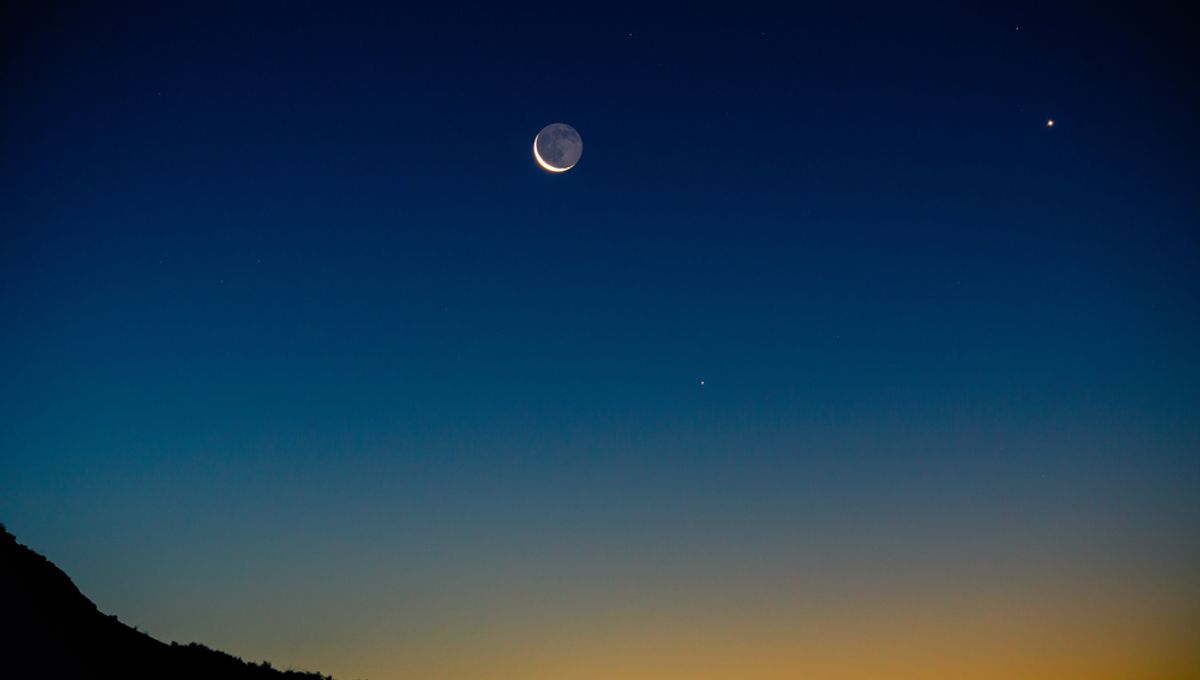
This month’s new Moon on April 20 is giving skywatchers plenty of reasons to look up this week. Not only is it instrumental in the rare once-in-a-decade type of eclipse happening on Thursday but it’s providing an exceptionally good opportunity to catch the phenomenon known as the Da Vinci Glow. Instead of just seeing the waning crescent Moon, you should be able to see the usually dark side of the lunar disk lit by a soft glow.
What is Da Vinci Glow?
Da Vinci Glow is also known as Earthshine and can technically be seen when any new Moon occurs, but it’s at its most intense in April.
During the Moon’s crescent phase right before or after a New Moon – when the crescent is at its skinniest – the dark part of the Moon appears lit by a mysterious light, which historically was known as “the old Moon in the New Moon’s arms”, or “ashen glow”.
The phenomenon occurs when sunlight reflects off Earth’s surface and illuminates the unlit part of the New Moon when you can usually only see the crescent. When the Sun sets on the Moon it gets dark, but not completely dark – it still has a light source: Earth. If you were standing on the Moon, not only would Earth appear about four times larger than the Moon appears to us, but it would be around 50 times brighter than the Full Moon on Earth.
Sunlight reflected from our planet goes back out into space. Some of it passes the Moon, hits the lunar surface, and reflects back to our eyes, and some is absorbed by the dark lunar soil. Because the light is being reflected twice – once by Earth and once by the Moon – this light is much dimmer. Again, if you were standing on the Moon it would look like twilight. The bright crescent we see clearly from Earth, however, is lit by direct sunlight, which is why it’s brighter.
Why is Earthshine called Da Vinci Glow?
Post landing humans on the Moon, it may seem obvious what is happening, but back in the 1500s, no one had been to the Moon to look back at Earth and see how much it lit up the lunar surface. This mysterious “ashen glow” was considered a riddle – one that Leonardo da Vinci was determined to solve.
Back then, people didn’t know the Earth orbited the Sun. Copernicus wouldn’t publish his Sun-centric theory of the Solar System until 24 years after da Vinci’s death. So to work out what was happening, you needed a wild imagination, which of course da Vinci had.
OK, he may have got a couple of things wrong, but he was the first person to correctly surmise that the bright crescent we see of a New Moon is lit directly by the Sun and the “ashen glow” is lit by reflected light from Earth.
In his Codex Leicester, written around 1510, he included a chapter titled “Of the Moon: No Solid Body is Lighter than Air”. In it, he explained his belief that the “ghostly glow” was caused by sunlight bouncing off Earth’s oceans and in turn hitting the Moon and reflecting back. The Moon was a fine reflector due to it being covered in oceans itself, he thought. Now, we know that Earth’s clouds do most of the planet’s reflecting and the closest the Moon has to an ocean is the Sea of Tranquility, which may have once been a large body of water and is where humans first landed on the Moon.
How can I see Da Vinci Glow?
You can see Earthshine whenever there’s a crescent Moon on the horizon right after sunset or before sunrise.
The faintly lit side of the Moon should be visible for a few days before and up to five days after a new Moon. You don’t need any specialized equipment, you can see it with the naked eye, but after five days, you may need to dig out a telescope if you want to continue watching the Earthshine.
The new Moon is on Thursday, April 20, so depending on where (and when) you are, enjoy its offerings, from Earthshine to the hybrid eclipse. And don’t forget to look up two days later when the Lyrids meteor shower is set to peak.
Source Link: What Is Da Vinci Glow And How To See It This Week